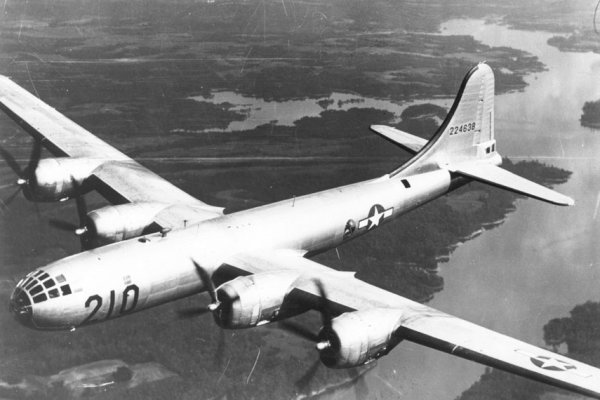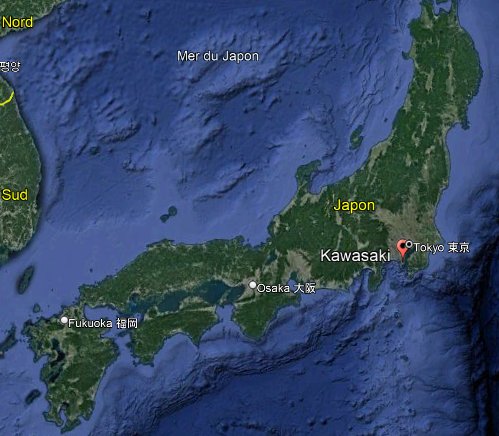ACUFO-1945-04-15-KAWASAKI-2
Two members of a B-29 crew reported independently their memories on the night bombing raid over Kawasaki, Japan, on April 15, 1945.
Both were flying the B-29-55-BW «City Of Dallas», formerly nicknames «Joe's Junk», of the 19th Bomb Group, 28th Squadron, XXth Air Force of the U.S. Army Air Forces, based on Guam at the time.
First, Capt. Joseph D. Brasfield, Navigator in the crew, noted in his missions diary, that...
The Japs are getting fanatic in the defense of their cities. Our crew spotted several "Balls of Fire". They are small Jap suicide flying bombs. Several of them disintegrated plainly in sight. Lights and guns were giving some of the unfortunate fellows plain Hell, but we got through without a scratch to a single crew member.
Then, 2nd. Lt. Robert Turkisher, Flight Engineer in the same crew, told:
As we started our bomb run I, as flight engineer, had little to do except watch my instruments and occasionally look out of my little window located on the right side of the aircraft.
By the time we were about half-way down our bomb run, I looked out the window and saw a ball of fire in the distance. I promptly reported, in a calm voice, “Ball of fire at three o'clock.” Our gunners could do nothing but watch, since we carried no ammunition. Several seconds later I keyed the inter-com and said, “Ball of fire at three o'clock and closing fast.” Then added in a more agitated and concerned voice, “Ball of fire! Ball of Fire! Ball of Fire!”
With my last “Ball of fire,” we dropped our bomb load, and as we did, another B-29 pulled abreast of us and exploded, apparently hit by the fire ball.
| Date: | April 15, 1945 |
|---|---|
| Time: | Night. |
| Duration: | ? |
| First known report date: | 1987 |
| Reporting delay: | Decades. |
| Country: | Japan |
|---|---|
| State/Department: | Kanagawa |
| City or place: | Kawasaki |
| Number of alleged witnesses: | 4 or more. |
|---|---|
| Number of known witnesses: | 2 |
| Number of named witnesses: | 2 |
| Reporting channel: | Personal War memories. |
|---|---|
| Visibility conditions: | Night. |
| UFO observed: | Yes. |
| UFO arrival observed: | Yes. |
| UFO departure observed: | Yes. |
| UFO action: | Approach, explode. |
| Witnesses action: | Alerts crew. |
| Photographs: | No. |
| Sketch(s) by witness(es): | No. |
| Sketch(es) approved by witness(es): | No. |
| Witness(es) feelings: | |
| Witnesses interpretation: | "Baka". |
| Sensors: |
[X] Visual: 4 or more.
[ ] Airborne radar: [ ] Directional ground radar: [ ] Height finder ground radar: [ ] Photo: [ ] Film/video: [ ] EM Effects: [ ] Failures: [ ] Damages: |
|---|---|
| Hynek: | NL |
| Armed / unarmed: | Unarmed. |
| Reliability 1-3: | 2 |
| Strangeness 1-3: | 1 |
| ACUFO: | Probable air-air rockets. |
[Ref. jbd1:] JOSPEH D. BRASFIELD:
Capt. Brasfield, Joseph D., Navigator in the crew of B-29-55-BW «City Of Dallas», noted in his missions diary, for the mission of April 15, 1945, a bombing raid over Kawasaki:
After our bombs were away, Bishop called over interphone to say that we were going to hit a column of smoke. About ten seconds later, we came the closest in all our experiences to meeting our end. This thermal, a column of hot air and smoke, that was rising above the fires had more force than any stream of compressed air ever could. It tossed us around like a cork in a creek. I did not have my safety belt fastened so I was thrown up against the roof of the navigator's compartment. All of my papers, maps, and instruments went in different directions. We gained 2,500 feet in 15 seconds. Those wings must have flexed their maximum of 12 feet, but they held. together. That was all that mattered just then.
Joe Simmons later told us that he lost all control of the ship while we were caught in that thermal. He had everything set to dive the ship, but we still ascended at a rate of better than 3,000 feet per minute. He said that all he could do was to try to hold the wings level and hope that the ship would hold together. The fact that I am now writing this account proves that it did just that.
The Japs are getting fanatic in the defense of their cities. Our crew spotted several "Balls of Fire". They are small Jap suicide flying bombs. Several of them disintegrated plainly in sight. Lights and guns were giving some of the unfortunate fellows plain Hell, but we got through without a scratch to a single crew member.
[Ref. rtr1:] ROBERT TURKISHER:
Flight engineer, 28th Squadron, 19th Bomb Group
On April 15, 1945, our unit took part in a low-level raid on Yokohama.
Our crew was pleased when we learned that we would fly as the last of ten “pathfinders.” Our load consisted of 14,000 pounds of incendiaries and 1,000 pounds of delayed action anti-personnel bombs.
Our takeoff from Guam's North Field was normal, as was our climb to our cruising altitude of 6,000 feet. And nothing unusual occurred on our long flight in darkness to our initial point, where we would commence our bomb run. We had been briefed too [to] be on the lookout for “balls of fire” that the Japanese were reportedly putting in the air. No one knew exactly what they were, but on the previous night crews from Saipan and Tinian had reported that these fire balls seemed to be trying to ram our aircraft and might be a new type of enemy plane.
As we started our bomb run I, as flight engineer, had little to do except watch my instruments and occasionally look out of my little window located on the right side of the aircraft.
By the time we were about half-way down our bomb run, I looked out the window and saw a ball of fire in the distance. I promptly reported, in a calm voice, “Ball of fire at three o'clock.” Our gunners could do nothing but watch, since we carried no ammunition. Several seconds later I keyed the inter-com and said, “Ball of fire at three o'clock and closing fast.” Then added in a more agitated and concerned voice, “Ball of fire! Ball of Fire! Ball of Fire!”
With my last “Ball of fire,” we dropped our bomb load, and as we did, another B-29 pulled abreast of us and exploded, apparently hit by the fire ball. At the same time, our aircraft was hurled straight up into the air and went from 6,000 feet to 25,000 feet in a matter of seconds. Both Joe Simmons, our pilot, and Wayne Christensen, our co-pilot, wrestled with the controls just to keep the wings level. As soon as we topped out at 25,000 feet, our plane - “The City of Dallas” - plunged rapidly toward the earth, seemingly out of control. With a tremendous jar that almost pulled the wings off the plane, we stopped our descent at 3,000 feet.
As soon as we left the target area I climbed into the bomb bay to see if there was any visible damage. I could not see any, but I was certain that the bolts holding the wings to the fuselage were stripped. We then climbed to 25,000 feet and set our course for home.
Back on the ground we inspected the plane with our crew chief, S/Sgt Poole and could find nothing wrong with it. We were impressed at what a strong and airworthy plane the Boeing B-29 was.
My notes to shed light on this story:
The Boeing B-29 “Superfortress” was the heaviest bomber of the U.S. Army Air Forces, used in operations from May 8, 1944 and on. Its maximum speed was 574 km/h.
Its defensive armament was 12 Browning M2 12.7 mm machine guns.

|

|
Historical sources indicate that B-29-55-BW «City Of Dallas», formerly «Joe's Junk» of the 19th Bomb Group, 28th Squadron, serial number 42-24883, carried out missions notably on March 8, 1945 on Tokyo, March 18, 1945 on Nagoya, April 2, 1945 on Shizuoka, April 11, 1945 on Hodagaya and Koriyama, on April 15, 1945 on Kawasaki (8 km from Yokohama), and on May 3, 1945 on Kanoya air base, mission during which it was noted «missing» after the Japanese Flak destroyed its fuel distribution system. It is unknown what happened to this crew (“The B-29 Superfortress - A Comprehensive Registry of the Planes and Their Missions”, by Robert A. Mann).
Historical sources document the crew, #31, as of February 28, 1945: the Aircraft Commander was Captain Joe L. Simmons, the Crew Chief was S/Sgt Kenneth Poole, and 2nd. Lt. Robert Turkisher was indeed the Flight Engineer. 1st Lt. Kenneth L. Bishop was the bomber.
Turkisher specified in his account that this mission was the last for this crew; the pilot, navigator, engineer, radio operator, bombardier, and radar operator returned to the USA for crew leader training. At the end of the war, of those who remained in the Pacific, only the co-pilot, Wayne Christensen, had survived - he had changed crew.
The only sure thing in this case is that balls of fires were seen during this mission.
The navigator, Capt. Joseph D. Brasfield, told the crew saw "several" of them; Flight Engineer Robert Turkisher reported only one of them.
Capt. Brasfield said they were "small Jap suicide flying bombs"; i.e., the "Baka" suicide rocket-plane. This was one of the explanations considered at the time. But no firm evidence surfaced that even one "Baka" was used against the B-29's. His information that "Several of them disintegrated plainly in sight" suggests that these were non-piloted air-air rockets that "missed", though it is not quite obvious that they would explode in mid-air.
Flight Engineer Robert Turkisher told of a ball of fire closing in, and then another "B-29 pulled abreast of us and exploded, apparently hit by the fire ball." As he told "apparently", it is not entirely sure that this B-29 was hit by the "ball of fire" he saw. But again, this can be explained by an air-air rocket.
Most of the other "balls of fire" reports tend to indicate that the "balls of fire" never attacked the B-29's. But at the time of this sighting, and as the two accounts show, all the crews did know about the "balls of fire" already reported, and it is quite logical that they would call "ball of fire" any Japanese air-air rocket when they did not see the enemy plane that fired it. It is also logical that they would not have seen it because, as navigator and flight engineer, they would only have limited view through the small windows in the fuselage.
Probable air-air rockets.
* = Source is available to me.
? = Source I am told about but could not get so far. Help needed.
| Main author: | Patrick Gross |
|---|---|
| Contributors: | None |
| Reviewers: | None |
| Editor: | Patrick Gross |
| Version: | Create/changed by: | Date: | Description: |
|---|---|---|---|
| 0.1 | Patrick Gross | July 20, 2024 | Creation, [jbf1], [rtr1]. |
| 1.0 | Patrick Gross | July 20, 2024 | First published. |